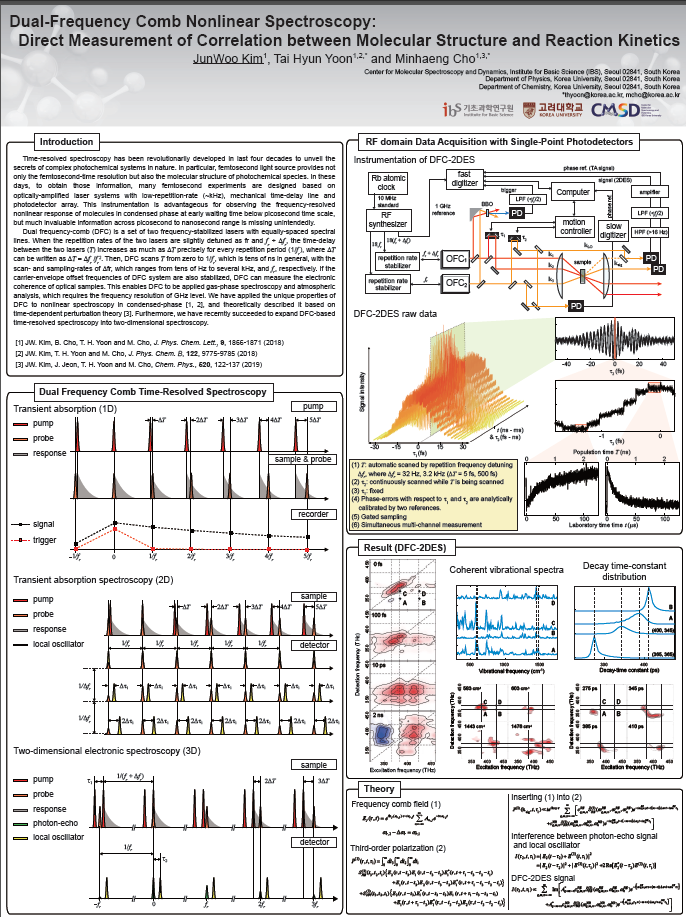mainmenu
Dual-Frequency Comb Nonlinear Spectroscopy: Direct Measurement of Correlation between Molecular Structure and Reaction Kinetics
2019 ICUSD

Time-resolved spectroscopy has been revolutionarily developed in last four decades to unveil the secrets of complex photochemical systems in nature. In particular, femtosecond light source provides not only the femtosecond-time resolution but also the molecular structure of photochemical species. In these days, to obtain those information, many femtosecond experiments are designed based on optically-amplified laser systems with low-repetition-rate (~kHz), mechanical time-delay line and photodetector array. This instrumentation is advantageous for observing the frequency-resolved nonlinear response of molecules in condensed phase at early waiting time (T) below picosecond time scale, but much invaluable information across picosecond to nanosecond range is missing unintendedly. Recently, we have developed and proposed time-resolved dual-frequency comb nonlinear spectroscopy (DCNS) with completely different instrumentation; dual frequency comb (DFC), non-mechanical time-delay generation, and single point photodetector [1, 2]. Frequency comb is a light source generating a successive pulse train with an equal time-interval and the same carrier-envelope-phase. Due to its peculiar property, frequency comb has been utilized for precision measurement, high-resolution spectroscopy. Particularly, DFC had brought remarkable development on gas-phase spectroscopy, microscopy, ellipsometry and multidimensional spectroscopy [3]. Slightly detuned repetition rates of two frequency combs (fr and fr + Dfr) linearly increase the pulse-to-pulse time-delay between them at a point (T), where the increment of T (DT) is determined by fr and Dfr as

DFC precisely scans the time-delay as long as 1/fr with uniform spatial beam quality with the scan rate of Dfr. Here, we applied the automatic time-delay generation of DFC for time-resolved spectroscopy to measure unexplored parts of nonlinear response of molecules in condensed-phase. The intrinsically wide dynamic range of T in DCNS provides not only nanosecond four-wave-mixing experiment but also high-resolution coherent vibrational spectroscopy, which informs molecular structure and dynamics of the photochemical species of interest. Due to its unique capabilities in fast scan rate, timing stability, and accuracy, DCNS has various advantages in addition to its non-mechanical time-delay generation. Firstly, the use of single-point photodetector makes the experimental setup simpler and is advantageous for the experiments requiring multichannel detection, such as anisotropy and optical activity measurement. Second, the full-interferometric measurement of DFC experiment provides both real and imaginary parts of molecular nonlinear response, and does not consume optical energy for spectral resolving. Thus it can use the minimum energy required for time-resolved spectroscopy.
In this presentation, we introduce three DCNS methods, which are DFC-transient absorption, DFC-interferometric pump-probe spectroscopy, and DFC-two-dimensional electronic spectroscopy. All the three techniques have inherently wide dynamic ranges, so they can obtain high-resolution coherent vibrational spectrum and nanosecond population dynamics, which are necessary quantities to unveil the correlation between the molecular structure and reaction kinetics of photochemical reaction systems. We anticipate that the unique properties of DFC-based time-resolved spectrometer would be a useful tool for investigating various photochemical systems.
References
[1] JW. Kim, B. Cho, T. H. Yoon and M. Cho, J. Phys. Chem. Lett., 9, 1866-1871 (2018).
[2] JW. Kim, T. H. Yoon and M. Cho, J. Phys. Chem. B, 122, 9775-9785 (2018).
[3] JW. Kim, J. Jeon, T. H. Yoon and M. Cho, Chem. Phys., 520, 122-137 (2019).


